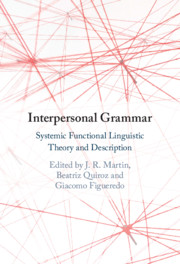Book contents
- Interpersonal Grammar
- Interpersonal Grammar
- Copyright page
- Contents
- Figures
- Tables
- Contributors
- 1 Introduction: Theory and Description in Interpersonal Grammar across Languages
- 2 Interpersonal Grammar in Spanish
- 3 Interpersonal Grammar in Khorchin Mongolian
- 4 Interpersonal Grammar in Mandarin
- 5 Interpersonal Grammar in Tagalog: Assessment Systems
- 6 Interpersonal Grammar of Pitjantjatjara
- 7 Interpersonal Grammar in Brazilian Portuguese
- 8 Interpersonal Grammar in British Sign Language
- 9 Interpersonal Grammar in Scottish Gaelic
- Index
- References
9 - Interpersonal Grammar in Scottish Gaelic
Published online by Cambridge University Press: 21 May 2021
- Interpersonal Grammar
- Interpersonal Grammar
- Copyright page
- Contents
- Figures
- Tables
- Contributors
- 1 Introduction: Theory and Description in Interpersonal Grammar across Languages
- 2 Interpersonal Grammar in Spanish
- 3 Interpersonal Grammar in Khorchin Mongolian
- 4 Interpersonal Grammar in Mandarin
- 5 Interpersonal Grammar in Tagalog: Assessment Systems
- 6 Interpersonal Grammar of Pitjantjatjara
- 7 Interpersonal Grammar in Brazilian Portuguese
- 8 Interpersonal Grammar in British Sign Language
- 9 Interpersonal Grammar in Scottish Gaelic
- Index
- References
Summary
In this chapter I use a text-based approach to grammatical description in order to explore the interpersonal grammar of Scottish Gaelic. I analyse extracts from two Scottish Gaelic novels from the perspectives of the semantic systems of NEGOTIATION and ENGAGEMENT and correlate distinctions in these systems with function structures at the lexicogrammatical stratum. By these means I build up a partial systems network for MOOD in Gaelic profile, with choices and distinctive features represented in the most economical way and labelled according to their distinctive usages in discourse. On the basis of this analysis, I will suggest that Scottish Gaelic does not have a [declarative] versus [interrogative] opposition in MOOD, redounding with the system of NEGOTIATION at the semantic stratum, but rather an [assertive] versus [non-assertive] opposition, redounding with the system of ENGAGEMENT at the semantic stratum.
- Type
- Chapter
- Information
- Interpersonal GrammarSystemic Functional Linguistic Theory and Description, pp. 257 - 284Publisher: Cambridge University PressPrint publication year: 2021
References
- 2
- Cited by



